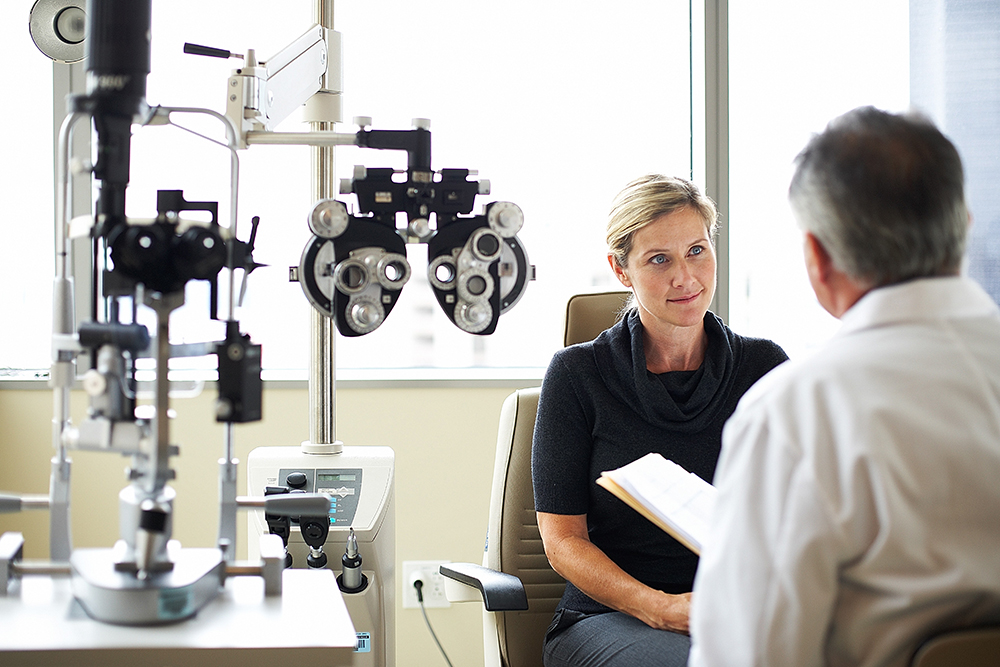
你或許聽說過“篩查拯救生命”這句諺語,,或許你已經(jīng)進行了或你的醫(yī)生建議你進行從糖尿病和抑郁癥到宮頸癌和結(jié)直腸癌等一系列常規(guī)篩查,。這些篩查獨立于常規(guī)血壓監(jiān)測和膽固醇篩查之外,,后者是年度健康護理的組成部分。
杜克初級保健診所阿靈頓家庭醫(yī)學(xué)(Duke Primary Care Arringdon Family Medicine)的家庭醫(yī)生索恩達·P·諾曼博士表示:“篩查是預(yù)防性醫(yī)療的重要組成部分,。我們希望在疾病變成麻煩并產(chǎn)生不可逆的后果之前,,提前發(fā)現(xiàn)病癥?!?/p>
以下是三十幾歲,、四十幾歲和五十幾歲時需要做的篩查。
三十幾歲

抑郁癥
2023年,,抑郁癥患病率創(chuàng)歷史最高,有29%的成年人表示確診患有抑郁癥,,比2015年高10%,。
2022年,獨立醫(yī)療專業(yè)小組美國預(yù)防醫(yī)學(xué)工作組(United States Preventive Services Task Force,,USPSTF)建議所有成年人進行抑郁癥篩查,。該工作組致力于提供循證預(yù)防性醫(yī)療建議。
醫(yī)生可能會在你第二次就診時詢問你的胃口和睡眠模式變化,、憂傷感或者缺少動機等情況,以確定你是否正在經(jīng)歷抑郁,。埃默里大學(xué)醫(yī)學(xué)院(Emory University School of Medicine)家庭醫(yī)學(xué)系主任和埃默里初級護理項目負(fù)責(zé)人緹娜-安·湯普森博士認(rèn)為,,成年后應(yīng)該堅持每年進行一次篩查。
宮頸癌
女性應(yīng)從三十歲開始進行人乳頭瘤病毒(HPV)篩查,,HPV病毒是幾乎一半高危型宮頸癌前病變的罪魁禍?zhǔn)住?/p>
華盛頓大學(xué)圣路易斯分校(Washington University in Saint Louis)的內(nèi)科醫(yī)生馬修·邦澤萊特博士表示:“年輕女性可能感染這種病毒,,有時候她們可以自動消滅這種病毒。如果在三十歲時[病毒]依舊存在,,這應(yīng)該引起我們的密切關(guān)注,。”
除了常規(guī)試紙檢測以外,,無論你的性生活史和HPV疫苗接種情況是怎樣的,,建議每五年進行一次篩查。對于宮頸癌高風(fēng)險患者,,醫(yī)療保健提供者可能建議更早或更頻繁地進行篩查,。
糖尿病
從三十五歲開始,應(yīng)該通過血糖檢測篩查糖尿病前期和糖尿病,。雖然美國預(yù)防醫(yī)學(xué)工作組建議超重或肥胖者進行糖尿病篩查,,但美國糖尿病協(xié)會(American Diabetes Association)建議,三十五歲及以上的成年人無論存在哪些風(fēng)險因素,,都要進行糖尿病篩查,。
湯普森表示,,醫(yī)生還可能根據(jù)你的健康和風(fēng)險因素,建議三十歲以后的成年人進行性傳播傳染病和人類免疫缺陷病毒(HIV)篩查,。
四十幾歲

視力
衰老與視力變化密切相關(guān),,因此建議四十歲的成年人進行眼科篩查。通過篩查可以檢測青光眼和白內(nèi)障等眼科疾病,。在四十歲以后,,這些疾病會變得更常見。
邦澤萊特表示:“隨著時間的推移,,眼睛晶狀體會變得僵硬,,這會改變它們近視和遠視調(diào)節(jié)的能力。這些疾病通常會在步入四十歲時開始出現(xiàn),?!?/p>
結(jié)直腸癌
五十歲以下結(jié)直腸癌發(fā)病率有所提高,有超過10%的新增結(jié)直腸癌病例來自五十歲以下的成年人,。因此,,建議從四十五歲開始進行結(jié)直腸癌篩查。
馬薩諸塞大學(xué)陳氏醫(yī)學(xué)院(UMass Chan Medical School)家庭醫(yī)學(xué)與社區(qū)健康副教授羅納德·阿德勒博士表示:“結(jié)直腸癌篩查非常重要,,但并非只有結(jié)腸鏡檢查這一種方式,;糞便檢測也是一種很好的選擇。最好的檢查是真正完成的檢查,?!?/p>
乳腺癌
今年早些時候,美國預(yù)防醫(yī)學(xué)工作組發(fā)布了新版乳腺癌篩查指南,。該工作組將存在一般乳腺癌風(fēng)險的女性兩年一次篩查的建議年齡從五十歲降低到四十歲,。(美國癌癥協(xié)會(American Cancer Society)自2003年起,建議從四十歲開始每年進行一次乳房X光造影檢查,。)
美國預(yù)防醫(yī)學(xué)工作組提到調(diào)整篩查指南的原因之一是,,黑人女性乳腺癌死亡率更高。
但乳房X光造影檢查的有效性與《新英格蘭醫(yī)學(xué)雜志》(New England Journal of Medicine)上發(fā)表的一項研究相矛盾,。該項研究發(fā)現(xiàn),,乳腺癌篩查結(jié)果增加與乳腺癌過度診斷之間存在密切聯(lián)系。
阿德勒表示:“乳房X光造影檢查被過度診斷的乳腺癌比例,,一直存在爭議,,過度診斷的比例至少達到15%,甚至可能高達30%,。因此,,2,400名四十歲年齡段的女性需要進行篩查以預(yù)防一例乳腺癌死亡病例,其中會有數(shù)百例假陽性和十多例過度診斷病例,?!?/p>
如果你的醫(yī)療保健提供者建議從四十歲開始進行乳房X光造影檢查,,阿德勒建議咨詢這項篩查潛在的副作用,并根據(jù)自己的風(fēng)險因素做出決策,。
五十幾歲

前列腺癌
在五十歲左右應(yīng)該開始考慮前列腺癌檢查(如果你是四十五歲或以上的非裔美國人,,或者至少有一位一級親屬被確診前列腺癌,你將面臨較高的患病風(fēng)險,,因此你的醫(yī)療保健提供者可能建議更早進行篩查),。
邦澤萊特指出,前列腺癌篩查包括通過驗血檢測前列腺特異性抗原(PSA)水平,,或進行直腸指檢,。
阿德勒補充道:“任何人在進行前列腺癌篩查之前,應(yīng)該首先參與[與其醫(yī)療保健提供者的]共同決策過程,,以了解自身的風(fēng)險,、福利和偏好與價值觀?!?/p>
肺癌
建議煙民進行肺癌篩查,。
對于有二十年“吸煙年包數(shù)”的煙民,建議進行低劑量計算機軸向斷層(CAT)掃描,?!拔鼰熌臧鼣?shù)”按每天吸煙數(shù)量乘以吸煙年數(shù)計算。二十年每天一包香煙和十年每天兩包香煙的“吸煙年包數(shù)”均為二十年,。
諾曼表示:“我們所篩查的是任何類型可能致癌的結(jié)節(jié)或物質(zhì),從而建議患者接受恰當(dāng)?shù)闹委?,或至少建議進行更頻繁的監(jiān)控,。”
此外,,諾曼表示,,癌癥篩查也是一次機會,可以勸告依舊在吸煙的人們戒煙,,并為他們提供必要支持以成功戒煙,。
了解與年齡和風(fēng)險相關(guān)的篩查建議至關(guān)重要,你應(yīng)該始終與醫(yī)療保健提供者進行誠實的對話,,以確定適合自己的篩查,。(財富中文網(wǎng))
翻譯:劉進龍
審校:汪皓
你或許聽說過“篩查拯救生命”這句諺語,或許你已經(jīng)進行了或你的醫(yī)生建議你進行從糖尿病和抑郁癥到宮頸癌和結(jié)直腸癌等一系列常規(guī)篩查,。這些篩查獨立于常規(guī)血壓監(jiān)測和膽固醇篩查之外,,后者是年度健康護理的組成部分,。
杜克初級保健診所阿靈頓家庭醫(yī)學(xué)(Duke Primary Care Arringdon Family Medicine)的家庭醫(yī)生索恩達·P·諾曼博士表示:“篩查是預(yù)防性醫(yī)療的重要組成部分。我們希望在疾病變成麻煩并產(chǎn)生不可逆的后果之前,,提前發(fā)現(xiàn)病癥,。”
以下是三十幾歲,、四十幾歲和五十幾歲時需要做的篩查,。
三十幾歲
抑郁癥
2023年,抑郁癥患病率創(chuàng)歷史最高,,有29%的成年人表示確診患有抑郁癥,,比2015年高10%。
2022年,,獨立醫(yī)療專業(yè)小組美國預(yù)防醫(yī)學(xué)工作組(United States Preventive Services Task Force,,USPSTF)建議所有成年人進行抑郁癥篩查。該工作組致力于提供循證預(yù)防性醫(yī)療建議,。
醫(yī)生可能會在你第二次就診時詢問你的胃口和睡眠模式變化,、憂傷感或者缺少動機等情況,以確定你是否正在經(jīng)歷抑郁,。埃默里大學(xué)醫(yī)學(xué)院(Emory University School of Medicine)家庭醫(yī)學(xué)系主任和埃默里初級護理項目負(fù)責(zé)人緹娜-安·湯普森博士認(rèn)為,,成年后應(yīng)該堅持每年進行一次篩查。
宮頸癌
女性應(yīng)從三十歲開始進行人乳頭瘤病毒(HPV)篩查,,HPV病毒是幾乎一半高危型宮頸癌前病變的罪魁禍?zhǔn)住?/p>
華盛頓大學(xué)圣路易斯分校(Washington University in Saint Louis)的內(nèi)科醫(yī)生馬修·邦澤萊特博士表示:“年輕女性可能感染這種病毒,,有時候她們可以自動消滅這種病毒。如果在三十歲時[病毒]依舊存在,,這應(yīng)該引起我們的密切關(guān)注,。”
除了常規(guī)試紙檢測以外,,無論你的性生活史和HPV疫苗接種情況是怎樣的,,建議每五年進行一次篩查。對于宮頸癌高風(fēng)險患者,,醫(yī)療保健提供者可能建議更早或更頻繁地進行篩查,。
糖尿病
從三十五歲開始,應(yīng)該通過血糖檢測篩查糖尿病前期和糖尿病,。雖然美國預(yù)防醫(yī)學(xué)工作組建議超重或肥胖者進行糖尿病篩查,,但美國糖尿病協(xié)會(American Diabetes Association)建議,三十五歲及以上的成年人無論存在哪些風(fēng)險因素,,都要進行糖尿病篩查,。
湯普森表示,醫(yī)生還可能根據(jù)你的健康和風(fēng)險因素,建議三十歲以后的成年人進行性傳播傳染病和人類免疫缺陷病毒(HIV)篩查,。
四十幾歲
視力
衰老與視力變化密切相關(guān),,因此建議四十歲的成年人進行眼科篩查。通過篩查可以檢測青光眼和白內(nèi)障等眼科疾病,。在四十歲以后,,這些疾病會變得更常見。
邦澤萊特表示:“隨著時間的推移,,眼睛晶狀體會變得僵硬,,這會改變它們近視和遠視調(diào)節(jié)的能力。這些疾病通常會在步入四十歲時開始出現(xiàn),?!?/p>
結(jié)直腸癌
五十歲以下結(jié)直腸癌發(fā)病率有所提高,有超過10%的新增結(jié)直腸癌病例來自五十歲以下的成年人,。因此,,建議從四十五歲開始進行結(jié)直腸癌篩查。
馬薩諸塞大學(xué)陳氏醫(yī)學(xué)院(UMass Chan Medical School)家庭醫(yī)學(xué)與社區(qū)健康副教授羅納德·阿德勒博士表示:“結(jié)直腸癌篩查非常重要,,但并非只有結(jié)腸鏡檢查這一種方式,;糞便檢測也是一種很好的選擇。最好的檢查是真正完成的檢查,?!?/p>
乳腺癌
今年早些時候,美國預(yù)防醫(yī)學(xué)工作組發(fā)布了新版乳腺癌篩查指南,。該工作組將存在一般乳腺癌風(fēng)險的女性兩年一次篩查的建議年齡從五十歲降低到四十歲,。(美國癌癥協(xié)會(American Cancer Society)自2003年起,建議從四十歲開始每年進行一次乳房X光造影檢查,。)
美國預(yù)防醫(yī)學(xué)工作組提到調(diào)整篩查指南的原因之一是,,黑人女性乳腺癌死亡率更高。
但乳房X光造影檢查的有效性與《新英格蘭醫(yī)學(xué)雜志》(New England Journal of Medicine)上發(fā)表的一項研究相矛盾,。該項研究發(fā)現(xiàn),,乳腺癌篩查結(jié)果增加與乳腺癌過度診斷之間存在密切聯(lián)系。
阿德勒表示:“乳房X光造影檢查被過度診斷的乳腺癌比例,,一直存在爭議,過度診斷的比例至少達到15%,,甚至可能高達30%,。因此,2,400名四十歲年齡段的女性需要進行篩查以預(yù)防一例乳腺癌死亡病例,,其中會有數(shù)百例假陽性和十多例過度診斷病例,。”
如果你的醫(yī)療保健提供者建議從四十歲開始進行乳房X光造影檢查,,阿德勒建議咨詢這項篩查潛在的副作用,,并根據(jù)自己的風(fēng)險因素做出決策,。
五十幾歲
前列腺癌
在五十歲左右應(yīng)該開始考慮前列腺癌檢查(如果你是四十五歲或以上的非裔美國人,或者至少有一位一級親屬被確診前列腺癌,,你將面臨較高的患病風(fēng)險,,因此你的醫(yī)療保健提供者可能建議更早進行篩查)。
邦澤萊特指出,,前列腺癌篩查包括通過驗血檢測前列腺特異性抗原(PSA)水平,,或進行直腸指檢。
阿德勒補充道:“任何人在進行前列腺癌篩查之前,,應(yīng)該首先參與[與其醫(yī)療保健提供者的]共同決策過程,,以了解自身的風(fēng)險、福利和偏好與價值觀,?!?/p>
肺癌
建議煙民進行肺癌篩查。
對于有二十年“吸煙年包數(shù)”的煙民,,建議進行低劑量計算機軸向斷層(CAT)掃描,。“吸煙年包數(shù)”按每天吸煙數(shù)量乘以吸煙年數(shù)計算,。二十年每天一包香煙和十年每天兩包香煙的“吸煙年包數(shù)”均為二十年,。
諾曼表示:“我們所篩查的是任何類型可能致癌的結(jié)節(jié)或物質(zhì),從而建議患者接受恰當(dāng)?shù)闹委?,或至少建議進行更頻繁的監(jiān)控,。”
此外,,諾曼表示,,癌癥篩查也是一次機會,可以勸告依舊在吸煙的人們戒煙,,并為他們提供必要支持以成功戒煙,。
了解與年齡和風(fēng)險相關(guān)的篩查建議至關(guān)重要,你應(yīng)該始終與醫(yī)療保健提供者進行誠實的對話,,以確定適合自己的篩查,。(財富中文網(wǎng))
翻譯:劉進龍
審校:汪皓
You’ve heard the adage “screening saves lives” and you’ve probably undergone—or had your doctor recommend—a range of routine screenings from diabetes and depression to cervical and colorectal cancer. These screenings are in addition to regular blood pressure and cholesterol screenings that are part of annual wellness care.
“Screening is a big part of preventive care,” says Dr. Soenda P. Norman, a family physician with Duke Primary Care Arringdon Family Medicine. “We want to catch something before it becomes problematic and there are irreversible consequences.”
Here are the screenings you may need in your 30s, 40s and 50s.
In Your 30s
Depression
Rates of depression are at an all-time high with 29% of adults reporting a diagnosis of depression in 2023—10% higher than 2015.
In 2022, the United States Preventive Services Task Force (USPSTF), an independent medical panel that makes evidence-based recommendations for preventive care, recommended screening all adults for depression.
Your doctor might ask questions about changes in appetite and sleep patterns, feelings of sadness or struggles with motivation at your next appointment to determine if you are experiencing depression. Screenings will continue annually throughout adulthood, according to Dr. Tina-Ann Thompson, director of the Division of Family Medicine and the Emory program lead, primary care, at the Emory University School of Medicine.
Cervical cancer
Starting at age 30, those with a cervix should be screened for the human papillomavirus (HPV), which is responsible for almost half of all high grade cervical pre-cancers.
“Younger women can get the virus and sometimes clear it on their own,” says Dr. Matthew Bonzelet, internist at Washington University in Saint Louis. “If [the virus] is still present at [age] 30, we need to start paying closer attention.”
Screening is recommended every five years in addition to a regular pap test, regardless of your sexual history or HPV vaccination status. Healthcare providers may recommend earlier or more frequent screening for those who are at high risk of cervical cancer.
Diabetes
Blood glucose testing to screen for pre-diabetes and diabetes starts at age 35. While USPSTF only recommends screening those who are overweight or obese but the American Diabetes Association advises screening for all adults 35 and older, regardless of their risk factors.
Your doctor may also recommend screenings for sexually transmitted infections and human immunodeficiency virus (HIV) in your 30s, depending on your health and risk factors, Thompson adds.
In Your 40s
Vision
Aging is associated with changes to your vision, so a baseline eye disease screening with an ophthalmologist is recommended at age 40. The screening can detect eye diseases like glaucoma and cataracts that become more common when you reach your 40s.
“Over time, the lens in your eyes get stiff and that changes their ability to adjust to [see] near and far,” says Bonzelet. “The 40s is the general timeframe when that starts to happen.”
Colorectal cancer
The rates of colorectal cancer in adults under age 50 has increased and accounts for more than 10% of new colorectal cancer cases. As a result, screening is recommended starting at age 45.
“Colorectal cancer screening is incredibly important but colonoscopy is not the only way to do it; stool testing can be just as good,” says Dr. Ronald Adler, associate professor of family medicine and community health at UMass Chan Medical School. “The best test for that is the one that gets done.”
Breast cancer
Earlier this year, the USPSTF issued new draft guidance for breast cancer screening. The task force lowered the recommended age for biennial screening from 50 to 40 for women for women at average risk of breast cancer. (The American Cancer Society has recommended annal mammograms starting at age 40 since 2003).
The USPSTF pointed to higher rates of breast cancer death in Black women as one of the reasons for adjusting the screening guidelines.
But the effectiveness of mammography screening is controversial with one study, published in the New England Journal of Medicine, found strong links between increases in breast cancer screening and over-diagnosis of breast cancer.
“There are debates about the proportion of mammographically-detected breast cancers that are over-diagnosed; it’s at least 15% but could be as high as 30%,” Adler says. “So, 2,400 women in their 40s need to be screened to prevent one breast cancer death and in that group, there are going to be hundreds of false positives and about a dozen over diagnosed cases.”
If your healthcare provider suggests mammography starting at age 40, Adler suggests asking about the potential downsides to screening and making a decision based on your risk factors.
In Your 50s
Prostate cancer
Conversations about prostate cancer screening start around age 50 (though your healthcare provider might recommend screening earlier if you are 45 or older and African American or have at least one first-degree relative who was diagnosed with prostate cancer, putting you at high risk of developing the disease).
Bonzelet notes that a prostate cancer screening may include a blood test for levels of prostate-specific antigen (PSA) or a digital rectal exam.
“The screening for prostate cancer is set up that no man should have be screened until after he has participated in a shared decision making process [with his healthcare provider] in which he considers his risk, the benefits and his own preferences and values,” Adler adds.
Lung cancer
Smokers may be advised to undergo lung cancer screenings.
The low-dose CAT scans are recommended for those who have accumulated 20 “pack years” as smokers, which is a calculation of the number of cigarettes smoked per day multiplied by the number of years they have smoked. One pack of cigarettes per day for 20 years or two packs of cigarettes per day for 10 years is the equivalent of 20 pack years.
“We’re essentially looking for any sort of nodule or mass that could be cancerous so we can refer them to appropriate care or at least recommend more frequent surveillance,” says Norman.
Additionally, Norman notes that lung cancer screening is an opportunity to counsel those who are still actively smoking on smoking cessation and providing support they need to successfully quit.
It’s important to be aware of age and risk related screening recommendations, but you should always have honest conversations with your healthcare provider to decide which screenings are right for you.






